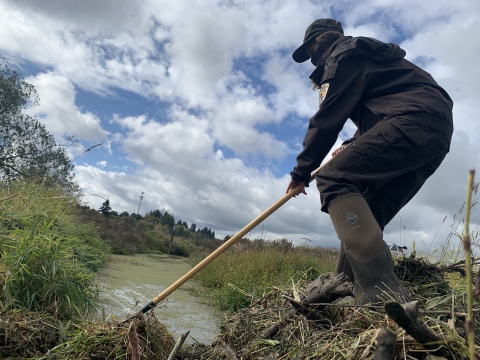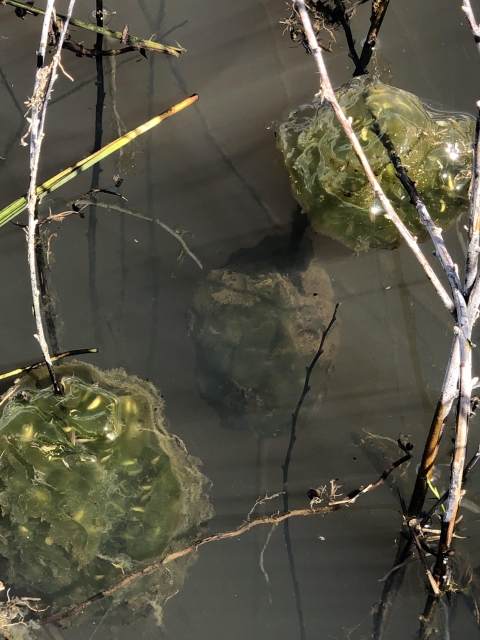What We Do
The National Wildlife Refuge System is a network of public lands and waters managed by the U.S. Fish and Wildlife Service. The System was established for the purpose of wildlife conservation, and directs all refuge actions and decisions. Utilizing the right management tools helps to further conservation and restoration of wildlife and their habitats.
Management and Conservation
Refuges use a wide range of land management practices in order to work towards restoration and management goals. These practices range from active approaches, such as prescribed burns and invasive plant removal, to more passive techniques. The methods and tools that are used are aimed to ensure a balanced conservation approach where both wildlife and people will benefit.
Cooperative farming - Updated February, 2025
Our refuge works with local land owners and farms to help manage portions of the lakebed for the benefit of migratory waterfowl and shorebirds.
The refuge will be seeking agricultural producers for our cooperative agriculture program on crop land on 5 fields totaling approximately 130 acres, in Washington and Yamhill counties for 1-5 years. To be considered, applicants must complete and submit the Bid Sheet Application and Special Use Permit. Applications must be received by March 30, 2025, and may be submitted by email to eva_kristofik@fws.gov or by mail to Tualatin River NWR, Attn: Eva Kristofik, 19255 SW Pacific Hwy., Sherwood, OR 97140.
Successful applicants will be selected through an open and competitive process. Bid sheets will be scored and ranked using objective criteria described in the Bid Sheet form. All applicants will be notified by April 10, 2025.
Additional information and requirements on cooperative agriculture opportunities can be found below. For questions, please contact Deputy Refuge Manager Eva Kristofik at 503-625-5944 or eva_kristofik@fws.gov.
Announcement of Refuge Seeking Agriculture Producers for Cooperative Agriculture Program
Special Conditions for Cooperative Agriculture Program at Wapato Lake NWR
Stop-over for migratory fly-ways
Among the four designated flyways in North America, Wapato Lake National Wildlife Refuge is along the Pacific Flyway; this migratory route is utilized by billions of birds every year, and spans from Alaska to South America.
Wapato Lake National Wildlife Refuge provides important habitat for migratory birds seeking refuge and respite along their migratory route. Refuge staff utilize different management actions to provide habitat and food for migratory birds, including restoration of the lake bed to permanent emergent marsh habitat, and restoration of surrounding edges to riparian riparian
Definition of riparian habitat or riparian areas.
Learn more about riparian habitat.
Prescribed fire
This management tool helps to clear sites of invasive plants as well as their seed banks before planting native species. Historically, the Kalaypuyan peoples utilized fire and prescribed burning to maintain habitats. Prescribed burns have occurred at Wapato Lake NWR, in order to clear noxious weeds such as blackberry. View our fire management plan for more information.
Habitat Restoration
Wapato Lake is currently being restored to emergent marsh habitat, and much of the area surrounding the lakebed is undergoing restoration to riparian habitat. Since the area was utilized as farmland previous to management by the U.S. Fish and Wildlife Refuge, considerable effort has been put into the control of and removal of invasive species invasive species
An invasive species is any plant or animal that has spread or been introduced into a new area where they are, or could, cause harm to the environment, economy, or human, animal, or plant health. Their unwelcome presence can destroy ecosystems and cost millions of dollars.
Learn more about invasive species , and has more recently begun to involve planting of native species. The restoration work at Wapato Lake National Wildlife Refuge is multi-year process, and will continue to be ongoing.
When planning and implementing various restoration projects, particular attention and consideration are given to listed species. Most habitat types encountered on refuge lands could support some or all life phases of any number of listed species such as the bald eagle, northern red-legged frog, northwestern pond turtle, and others.
Inventory and Monitoring
The U.S. Fish and Wildlife Service is charged to “monitor the status and trends of fish, wildlife, plants, in each refuge.” Our inventory and monitoring plan includes different types of surveys, all utilized to monitor the status and any changes to these species and habitats at our refuge. Currently, refuge staff conduct spring surveys for migratory songbirds, winter surveys for amphibian egg masses and migratory waterfowl, and various plant surveys in the summer.
Laws and Regulations
In order to provide and maintain our wildlife refuge as a home for a variety of wildlife, we ask that you follow our rules and guidelines while visiting and walking our trails.


